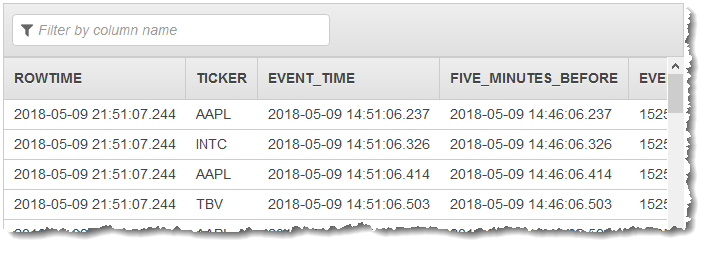After careful consideration, we have decided to discontinue Amazon Kinesis Data Analytics for SQL applications in two steps:
1. From October 15, 2025, you will not be able to create new Kinesis Data Analytics for SQL applications.
2. We will delete your applications starting January 27, 2026. You will not be able to start or operate your Amazon Kinesis Data Analytics for SQL applications. Support will no longer be available for Amazon Kinesis Data Analytics for SQL from that time. For more information, see Amazon Kinesis Data Analytics for SQL Applications discontinuation.
Example: Transforming DateTime Values
Amazon Kinesis Data Analytics supports converting columns to time stamps. For example, you might want to
use your own time stamp as part of a GROUP BY clause as another time-based
window, in addition to the ROWTIME column. Kinesis Data Analytics provides operations and
SQL functions for working with date and time fields.
-
Date and time operators – You can perform arithmetic operations on dates, times, and interval data types. For more information, see Date, Timestamp, and Interval Operators in the Amazon Managed Service for Apache Flink SQL Reference.
-
SQL Functions – These include the following. For more information, see Date and Time Functions in the Amazon Managed Service for Apache Flink SQL Reference.
-
EXTRACT()– Extracts one field from a date, time, time stamp, or interval expression. -
CURRENT_TIME– Returns the time when the query executes (UTC). -
CURRENT_DATE– Returns the date when the query executes (UTC). -
CURRENT_TIMESTAMP– Returns the time stamp when the query executes (UTC). -
LOCALTIME– Returns the current time when the query executes as defined by the environment on which Kinesis Data Analytics is running (UTC). -
LOCALTIMESTAMP– Returns the current time stamp as defined by the environment on which Kinesis Data Analytics is running (UTC).
-
-
SQL Extensions – These include the following. For more information, see Date and Time Functions and Datetime Conversion Functions in the Amazon Managed Service for Apache Flink SQL Reference.
-
CURRENT_ROW_TIMESTAMP– Returns a new time stamp for each row in the stream. -
TSDIFF– Returns the difference of two time stamps in milliseconds. -
CHAR_TO_DATE– Converts a string to a date. -
CHAR_TO_TIME– Converts a string to time. -
CHAR_TO_TIMESTAMP– Converts a string to a time stamp. -
DATE_TO_CHAR– Converts a date to a string. -
TIME_TO_CHAR– Converts a time to a string. -
TIMESTAMP_TO_CHAR– Converts a time stamp to a string.
-
Most of the preceding SQL functions use a format to convert the columns. The format is
flexible. For example, you can specify the format yyyy-MM-dd hh:mm:ss to
convert an input string 2009-09-16 03:15:24 into a time stamp. For more
information, Char To
Timestamp(Sys) in the Amazon Managed Service for Apache Flink SQL Reference.
Example: Transforming Dates
In this example, you write the following records to an Amazon Kinesis data stream.
{"EVENT_TIME": "2018-05-09T12:50:41.337510", "TICKER": "AAPL"} {"EVENT_TIME": "2018-05-09T12:50:41.427227", "TICKER": "MSFT"} {"EVENT_TIME": "2018-05-09T12:50:41.520549", "TICKER": "INTC"} {"EVENT_TIME": "2018-05-09T12:50:41.610145", "TICKER": "MSFT"} {"EVENT_TIME": "2018-05-09T12:50:41.704395", "TICKER": "AAPL"} ...
You then create an Kinesis Data Analytics application on the console, with the
Kinesis stream as the streaming source. The discovery process reads sample records on
the streaming source and infers an in-application schema with two columns
(EVENT_TIME and TICKER) as shown.

Then, you use the application code with SQL functions to convert the
EVENT_TIME time stamp field in various ways. You then insert the
resulting data into another in-application stream, as shown in the following
screenshot:

Step 1: Create a Kinesis Data Stream
Create an Amazon Kinesis data stream and populate it with event time and ticker records as follows:
Sign in to the AWS Management Console and open the Kinesis console at https://console.aws.amazon.com/kinesis
. -
Choose Data Streams in the navigation pane.
-
Choose Create Kinesis stream, and create a stream with one shard.
-
Run the following Python code to populate the stream with sample data. This simple code continuously writes a record with a random ticker symbol and the current time stamp to the stream.
import datetime import json import random import boto3 STREAM_NAME = "ExampleInputStream" def get_data(): return { "EVENT_TIME": datetime.datetime.now().isoformat(), "TICKER": random.choice(["AAPL", "AMZN", "MSFT", "INTC", "TBV"]), "PRICE": round(random.random() * 100, 2), } def generate(stream_name, kinesis_client): while True: data = get_data() print(data) kinesis_client.put_record( StreamName=stream_name, Data=json.dumps(data), PartitionKey="partitionkey" ) if __name__ == "__main__": generate(STREAM_NAME, boto3.client("kinesis"))
Step 2: Create the Amazon Kinesis Data Analytics Application
Create an application as follows:
Open the Managed Service for Apache Flink console at https://console.aws.amazon.com/kinesisanalytics
. -
Choose Create application, type an application name, and choose Create application.
-
On the application details page, choose Connect streaming data to connect to the source.
-
On the Connect to source page, do the following:
-
Choose the stream that you created in the preceding section.
-
Choose to create an IAM role.
-
Choose Discover schema. Wait for the console to show the inferred schema and the sample records that are used to infer the schema for the in-application stream created. The inferred schema has two columns.
-
Choose Edit Schema. Change the Column type of the EVENT_TIME column to
TIMESTAMP. -
Choose Save schema and update stream samples. After the console saves the schema, choose Exit.
-
Choose Save and continue.
-
-
On the application details page, choose Go to SQL editor. To start the application, choose Yes, start application in the dialog box that appears.
-
In the SQL editor, write the application code and verify the results as follows:
-
Copy the following application code and paste it into the editor.
CREATE OR REPLACE STREAM "DESTINATION_SQL_STREAM" ( TICKER VARCHAR(4), event_time TIMESTAMP, five_minutes_before TIMESTAMP, event_unix_timestamp BIGINT, event_timestamp_as_char VARCHAR(50), event_second INTEGER); CREATE OR REPLACE PUMP "STREAM_PUMP" AS INSERT INTO "DESTINATION_SQL_STREAM" SELECT STREAM TICKER, EVENT_TIME, EVENT_TIME - INTERVAL '5' MINUTE, UNIX_TIMESTAMP(EVENT_TIME), TIMESTAMP_TO_CHAR('yyyy-MM-dd hh:mm:ss', EVENT_TIME), EXTRACT(SECOND FROM EVENT_TIME) FROM "SOURCE_SQL_STREAM_001" -
Choose Save and run SQL. On the Real-time analytics tab, you can see all the in-application streams that the application created and verify the data.
-